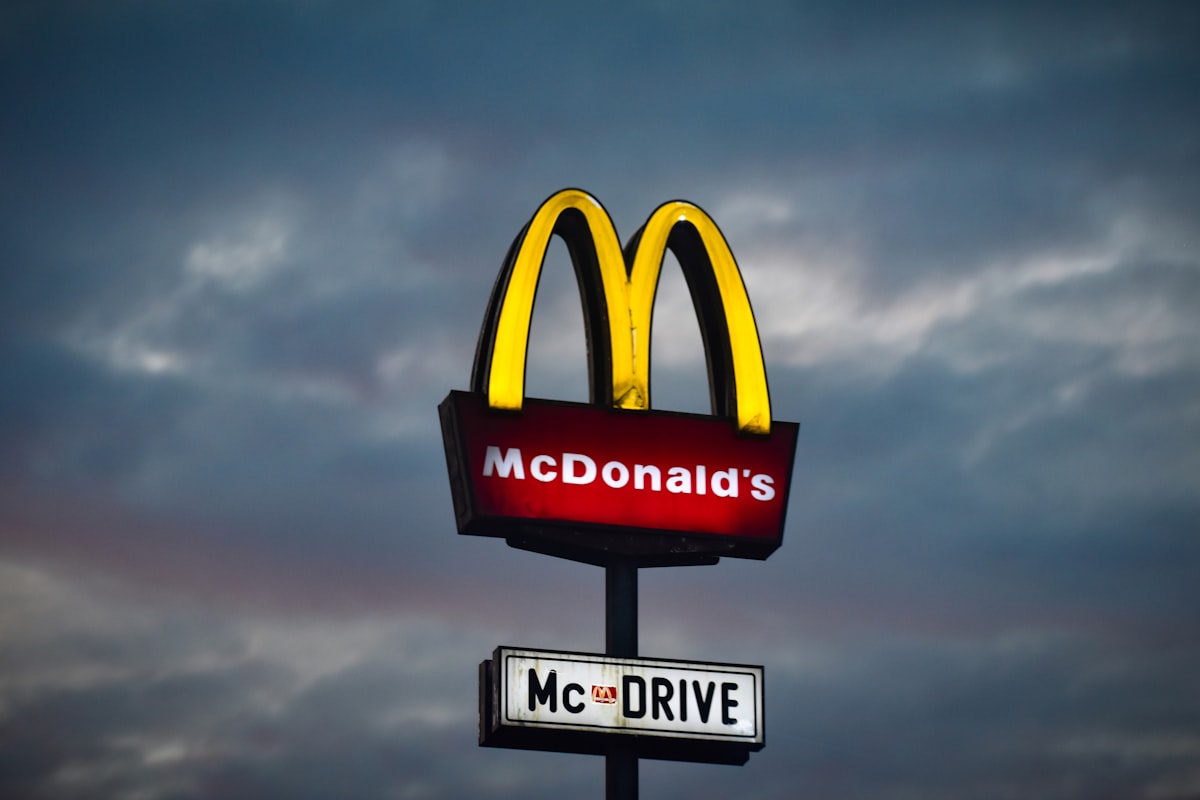McDonald's secret business empire: how McDonald's has amassed a $40 Billion real estate empire

Do you ever feel like McDonald's is everywhere? From the city center to remote rural areas and even inside airports, it's incredibly hard to escape their iconic golden arches. But did you know that, alongside churning out Big Macs, this fast food giant has a lucrative real estate business empire? From buying up prime development plots in established neighborhoods to raking in huge profits from hungry burger fans around the globe, there really is more behind those golden arches than meets the eye.
McDonald’s history became quite famous thanks to the biopic The Founder. Directed by John Lee Hancock and written by Robert Siegel, this movie tells the story of Ray Kroc and his journey as he built McDonald's into a billion-dollar burger empire with Mac and Dick McDonald.

Today McDonald's real estate portfolio has an estimated value of $40 billion. McDonald’s owns some of the most sought-after real estate plots and land across the globe, including prime locations in cities and rural areas alike.
McDonald's humble beginnings
The McDonald brothers, Dick and Mac McDonald, started their restaurant business back in 1940 with a small drive-in eatery in San Bernardino, California.

In April 1952, the brothers decided that they needed an entirely new building to achieve two goals: further efficiency improvements and a more eye-catching appearance. They collected recommendations for an architect, choosing Stanley Clark Meston. The brothers and Meston worked together closely in the design of the new building. They achieved the extra efficiencies that they needed by, among other things, drawing the actual measurements of every piece of equipment in chalk on a tennis court behind the McDonald house.
This new McDonald's was designed to be efficient and produce huge quantities of food at low prices. To achieve this, they limited their menu—which only included burgers, fries, drinks, and pie—and developed a simple system that eliminated the need for waiters or waitresses. Customers also received their food quickly, as McDonald's burgers were pre-cooked and placed under heat lamps until they were served. This allowed McDonald's to charge just 15 cents for a basic burger—which was half the price of competing restaurants.
As customers flocked to McDonald’s restaurants for its cheap menu items, the McDonald’s brothers saw an opportunity to expand their business. They soon sold 14 franchises of which 10 became operating restaurants—not including their original location in San Bernardino.
Ray Kroc steps in and makes history
Ray Kroc, a milkshake machine salesman, got intrigued by their need for eight malt and shake mixers. He visited the McDonald’s brothers to see how a small shop could sell so many milk shakes. Kroc saw the huge potential of what was standing in front of his eyes: he saw McDonald's becoming an empire, with franchises all over the United States. But when Kroc suggested this idea to the McDonald brothers, they were hesitant - after all, their business in San Bernardino was thriving and there were already plans for other territories. However, Kroc wasn't easily deterred; he eventually convinced them by offering to manage it himself! With that agreement made between him and the brothers came 0.5% of gross sales, while 1.4% would go to Kroc to drive further expansion.

Kroc opened the first McDonald’s east of the Mississippi river in Des Plaines, Illinois in 1955. However, Kroc was having a hard time making the business successful - his franchised restaurants weren't bringing in enough money. He had to tackle things one step at a time, taking on each restaurant individually instead of opening multiple spots all over the country like other fast-food chains did; it was tough finding investors who could cover both land and building expenses for each location.
In 1956, Ray Kroc was brainstorming ways to expand his McDonald's business when he crossed paths with Harry J. Sonneborn - a former Tastee-Freez exec. Kroc was presented with an innovative plan that would transform his McDonald's venture into a major success: Franchise Realty Corp. The new company signed leases and procured mortgages for both land and buildings, passing these costs on to the franchisee with a 20-40% markup and a reduced initial deposit of $950. Franchisees were also responsible for insurance and taxes, ensuring a steady profit for the company as long as the restaurant stayed in business. The genius of the Sonneborn financial model was that McDonald’s would earn royalty fees from franchisees and collect rent, as well as keep adding real estate assets to its portfolio. After McDonald’s switched to the Sonneborn model in 1958, the company added 68 locations in a year.
After the strategy was successfully implemented they realized that they could further develop their unique business model by having the franchisees either pay the monthly rent or give up a percentage of the sales for the month. This decision was made based on whichever figure was higher. This strategy proved to be very helpful, especially during times of recession when sales depreciated significantly.
This "Sonneborn model" is still around today, having undoubtedly been one of the most important decisions ever made by McDonalds over its history!

Sonneborn quoted ‘we are not technically in the food business. We are in the real estate business. The only reason we sell fifteen-cent hamburgers is because they are the greatest producer of revenue, from which our tenants can pay us our rent.’
In 1961, Kroc faced a rift with the two brothers who originally started McDonald's. Not wanting to lose out on taking control of their growing enterprise, he asked them how much they wanted for him to take full ownership - shockingly high at $2.7 million (today worth around $23 million). Thankfully his friend Harry J Sonneborn was able to rustle up some cash and the deal went through.
Ray Kroc knew that for McDonald's to take off, it needed a prime location. He purchased large pieces of land – far enough from competitors so the restaurants could be bigger and feature ample parking space as well as outdoor seating areas. But he didn't just rely on the physical presence alone - millions were poured into promotional efforts in order to create an iconic image recognizable all over the globe!
McDonald's success was heavily dependent on their franchisees, so Ray Kroc created stringent standards for how each of its outlets should be run. To make sure these requirements were being strictly followed he developed Hamburger University in 1961 to train the owners and staff.

Rapid expansion soon saw McDonald’s become a well-known household name worldwide! They opened up drive-through windows all over the U.S., bringing convenience as part of their regular offering - something that has stayed with them ever since; plus they've continued expanding internationally too, dominating real estate markets globally along the way!
McDonald’s has become one of the most recognizable brands in history due to its strategic real estate acquisitions and business model.
McDonald's aggressive expansion into new markets around the world
The company comes up with a variety of services and products catering to the needs of a consumer market that is widely diverse, basing their offerings on consumer demographics, local and economic factors. Two key tactics are at the base of the company's success: standardization and adaptation.
McDonald’s leverages its standardization strategy to efficiently produce and distribute the same products in a wide range of markets (think about McFlurry, McNuggets or Happy Meal, etc).
At the same time they do adapt the menu to local tastes and preferences hence you will find Rice burgers in Japan and Halal burgers in Indonesia.

McDonald's has been able to capitalize on the global trend of health consciousness, while still offering fast-food items that customers love. Think about the salads, or the fruit part of the Happy Meal. Or even the McCafè where you can eat products you would normally find in a bakery or cafè.
Today’s real estate empire
As of 2021, the company operates in 119 countries. Out of the 40031 McDonald's restaurants, 37295 or 93% were franchised, while the remaining 2736 were company operated. This totals to almost $42 billion worth of assets on the balance sheet, making McDonald's one one of the biggest real estate company in the world.

The restaurants are owned and operated under one of the following structures:
- Conventional franchise: McDonald's generally owns or secures a long-term lease on the land and building for the restaurant location and the franchisee pays for equipment, signs, seating and décor. To accelerate implementation of certain initiatives, McDonald's may co-invest with franchisees to fund improvements to their restaurants or operating systems. Conventional franchisees contribute to McDonald's revenue, primarily through the payment of rent and royalties based upon a percent of sales, with specified minimum rent payments, along with initial fees paid upon the opening of a new restaurant or grant of a new franchise.
- Developmental license: Licensees are responsible for operating and managing their businesses, providing capital (including real estate interest) and developing and operning new restaurants. McDonald's receives a royalty based on a percent of sales, and generally receives initial fees upon the opening of a new restaurant or grant a new lease.
- Affiliate: similar to developmental license but used in foreign markets (such as China and Japan), where McDonald's also has an equity investment.
The expertise from operating Company-owned restaurants allows McDonald's to improve the relevant operations and success of all restaurants while innovations from franchisees can be tested and, when viable, efficiently implemented across relevant restaurants. Having Company-owned and operated restaurants provides company personnel with a venue for a restaurant operations training experience. In addition, the company is able to further develop and refine operating standards, marketing concepts and product and pricing strategies that will ultimately benefit McDonald's restaurants
Franchisees act as entrepreneurs and maintain control over all employment related matters, marketing and pricing decisions.
How much money does McDonald's make?
At the time of writing, here’s how McDonald’s makes money from its franchises:
- One-time franchise fee of $45,000
- 3-month base rent of $313,000 or percentage rent of 31.75% of sales
- 4% commission on sales
- Advertising and promotion fee ( Not less than 4% of gross sales )
These fees, along with occupancy and operating rights, are stipulated in franchise/license agreement that generally have 20-year terms.
On average, franchisees have to spend around $1.5 to $2.5 million in total to start an outlet. According to Mashed.com, the average McDonald’s location makes $2.7 million in sales and around $150,000 in profit. Investing in McDonald’s may have a lower rate of return than other options, but the risk is also much less. After all, you don't start with zero brand recognition when acquiring a franchise – people already know what kind of food they're getting! And that means more money coming through the door and higher chances for success compared to starting your own restaurant concept from scratch.
Over the years McDonald's has been increasing the number of franchise-owned stores and decreasing the company-owned stores as McDonald's has been able to make more profit off their franchises than from a company-run operation.
For instance if we stick to 2021 data, McDonald’s made $9.7 billion in revenue from the 7% of their company-operated stores, but only $1.7 billion in profit due to expenses amounting to $8 billion. On the other hand McDonald’s made a revenue of $13 billion from its 93% franchise-run stores and profits stood at $10.7 million as it cost McDonald’s only $2.3 million to run them. It costs way more money to run your own store than it does to sit back and collect cash.

Conclusion
If we set aside personal preferences or how healthy it is to eat fast food, McDonald's is an interesting business to invest in as McDonald’s has a strong global presence with over 38,000 restaurants around the world and it continues to grow. McDonald’s has become very successful by relying heavily on franchising and real estate ownership instead of owning each individual restaurant. From an investor perspective McDonald’s is an attractive investment taking into account McDonald's low level of risk, steady streams of income from royalties, fees and real estate purchases and especially that McDonald’s paid its first dividend in 1976 and has increased it every year since, securing a spot in the dividends aristocrats (companies in the S&P 500 index that have increased their dividends in each of the past 25 consecutive years).
Further readings
- Grinding it out: the making of McDonald's by Ray Kroc. It comes directly from the man who transformed McDonald's from a single restaurant into a global empire.
- Fast Good Nation by Eric Schlosser. While it covers other fast-food chains, McDonald's serves as the central case study.
- Behind the Arches by John F. Love. Love had unprecedented access to company archives and executives, allowing him to uncover lesser-known stories about the company's development.
These are affiliate links to books I genuinely recommend—they're highly relevant, and I wasn't paid to select them. Your support helps keep Wealthy Parrot running at no extra cost to you. 🙌📚





